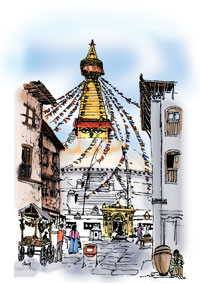 |
If one reads Desmond Doig and Dubby Bhagat's classic Down History's Narrow Lanes (just re-released after ten years by Braaten Books) one learns that Kathmandu Valley's vibrant culture and traditions were all governed by the heavens and the signs that came down from it.
It looks like Nepal always had droughts, even before global warming was discovered. In fact, one particularly bad one lasted decades until the Machhendranath chariot with its Karkat snake god and the deity from Assam brought the rain. Read about this and other festivals in Doig and Bhagat's book, which first came out in 1999 and had been out of print until recently.
The long-awaited new edition brings back to us Doig's exquisite line drawings of Kathmandu Valley temples, bahals and stupas (carried in weekly installments in this paper from 2000-2005 under the banner 'Saving Faith'). And it's not just the drawings, the language also has fairy-tale quality to it with chapter titles like: 'The Gate of the Vermilion God', 'Where Serpents Breathe Fire', 'The City Vishnu May Have Built', 'The Jewelled Gift of the Snake God', The Gorge of the Flaming Sword'.
They're about shrines we pass every day on the way to work, now dwarfed by taller, more recent constructions. It's about festivals in our midsts. It is therefore essential reading not just for expats but also for Kathmandu residents who have forgotten about their rich heritage.
 Down History's Narrow Lanes Kathmandu As It Was Then Desmond Doig and Dubby Bhagat Braaten Books, Denmark 2009 Rs 450 |
Doig and Bhagat have a great affinity for Nepal, and especially Kathmandu Valley, which becomes evident through affection with which they treat the subjects of their chapters. Doig died in 1984 and Bhagat lives in Kathmandu and is a writer for the The Himalayan Times. Both should have been made honorary Nepali citizens.
Let's hope that through this book, there will be more Nepalis who will research, write and communicate as well about our history and culture. In fact, a movie series based on the chapters of this book would be immediately doable, even though the old town has seen serious urban degradation since these sketches were done 30 years ago. Such a documentary series would take the message of our national identity and cultural diversity to a larger public at a time when we are looking for differences among us, rather than what binds us together as Nepalis.
Despite the fact that the chapters and sketches were done so long ago, they don't come across as dated at all. You realise the Valley's timeless quality when you read this lyrical concluding paragraph of the chapter on Bhaktapur:
'As the afterglow of sunset lingers on the snow sumits, the procession of shadows come home. Walking conversations. Laughter. Temple bells. A flute playing Nepalese love songs with its echo somewhere. A guitar plunking out tentative Paul Simon. That's magic enough for a lane anywhere. Even in magical Bhaktapur.'
See also:
'Doig's kind of Kathmandu' by Jug Suraiya, #53
POETIC LICENSE
BETTER THAN THAT
Wayne Amtzis
Blind rage
hungers for the kill
hawk eyes
thirst for the marrow
Busted bones
darken the sky
Let me tell you
the reason why
What happens
when vultures are crossed
with sheep?
A nation of souls
puts conscience to sleep
Each brutal act
has its excuse.
To be in on the kill,
to run with the pack-
a righteous wind at your back
nothing's better than that.
Blood thirst and loss
one and the same,
predator and prey
a singular name
Cross beak with hooves
a nation of citizens
forfeits its rights
Each shadowed witness
votes by day
for unending night
CORRESPONDENT'SLAMENT
No more
the rule of law
Death rules
man follows
Perfectly aligned
phrases taut,
knock back the whiskey
file your report
You've been
you're gone - false alarm
For those who stay
it's follow or pray
Far away,
you'll save the day
Coup d'tat!
They've gone too far
Fists in air,
the victors cry
(you'll catch the beat
and tell us why)
Kow-tow, ladies,
it's time to.. die!


